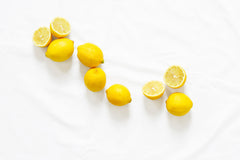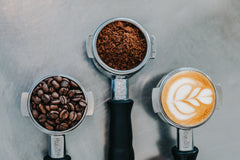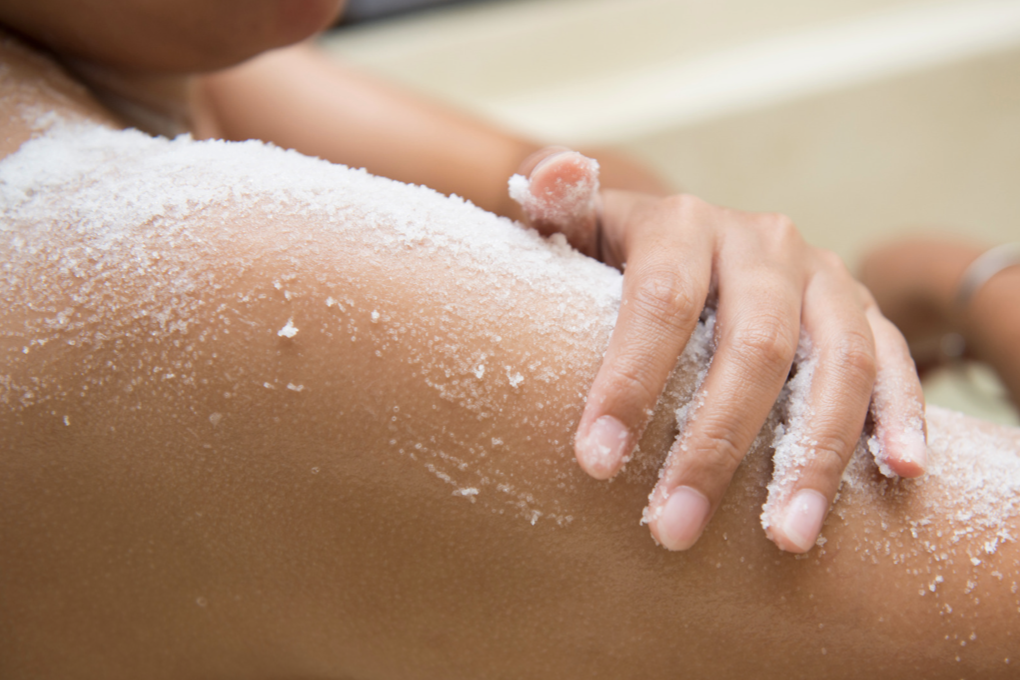Scrub or Peel? Salt or Sugar? How do I know what’s right for me?
Healthy skin starts from within, but it’s not a one-way street! A healthy within is heavily benefited by a healthy exterior, aided in part by releasing exterior cells that we no longer need. Exfoliants such as peels and scrubs are the primary ways to achieve that (there are a few extra tools, though – we’ll get into those too).
When you exfoliate, you:
-
- Aid the detoxification process by the removal of dead skin cells: exfoliating sloughs off dead skin cells – cells that have been fighting free radicals, pollution, and potentially harmful cosmetics or washes you were previously using.What’s more, dead skin cell (clinical term: keratinocyte) build-up heavily contributes to break-outs – it’s just more surface area for bacteria to fester. If the skin cells don’t break away in time, they collect in the hair follicles (pores), thereby clogging the pores. When you remove the skin cells, your skin breathes better!
- Reveal refreshed skin: removing the dull layer of dead skin reveals the fresh, healthy skin below, often appearing firmer and more glowing – just be sure to properly protect from the sun, as your fresh skin is more susceptible to UV damage.
- Allow for better absorption of moisturizer: since there are fewer dead skins blocking moisture from entering your living cells, you’ll gain more benefit from your moisturizer. Why is this important? Because proper moisturizer is one of the best ways to prevent wrinkles – second only to reducing your exposure to sun damage!
- Move lymph fluid, enabling lymphatic drainage: the lymph system, unlike the circulatory (blood) system, only flows in one direction – proper movement of lymph fluid requires your physical movement (through exercise, physical activities) and/or lymphatic drainage techniques (such as dry brushing, lymphatic massages, and exfoliation).You have lymphatic vessels running from your head to your toes; some lymph nodes are located deep inside the body, while others are closer to the surface (ahem, the skin!) – your lymphatic system is basically the “flushing” of all the bad stuff in your body. How does exfoliation help? As your skin gets older and/or sun-damaged, the lymphatic function closes to the dermis deteriorates; exfoliation gets the circulatory and lymphatic system moving.
- Become mindful and dedicated to your self-care: think of the 5 to 15 minutes you spend taking time exfoliating as “skincare yoga” – yoga is all about bringing your awareness to the here and now, unifying breath, body, and mind. When you take the time to envelope yourself in the care of an exfoliating technique, you’re giving yourself the space to be full immersed in the feel and scent of the present moment.
Scrub or Peel? What’s the difference?
A scrub is a physical exfoliant that uses its texture to physically slough off dead skin cells; scrubs can be mild (very small granules) or moderate/harsh (large granules). Facial scrubs will always be gentler than body scrubs, as the skin on your face is more delicate.
SALT versus SUGAR scrubs… and so many more! Salt and sugar are the most common scrubs you’ll find in stores, but there are tons of benefits to other particles that can slough off your dead skin cells.
Salt Scrub: granular (often large) salt particles are antiseptic and thus more “detoxifying” – certain salts also contain beneficial minerals (Dead Sea salt; Himalayan salt). Salt is one of the tougher exfoliants, and is not recommended for delicate skin – it’s great for feet, calluses, elbows, and knees. Do not use a salt scrub if you have any cuts or abrasions (or if you’ve just shaven) – ouch!
Sugar Scrub: smaller particles that are (usually) smaller in size than salt and thus gentler on skin. Sugar scrubs are not as detoxifying or mineral-bearing as salt, but they do have naturally occurring glycolic acid, acting almost like its own mini chemical peel. Sugar scrubs will not hurt any skin abrasions, are generally safe for sensitive skin, and are totally painless on recently shaven legs.
Coffee Scrub: the particles of the coffee will depend entirely on the size of the grounds (espresso being smaller); because coffee grounds contain caffeine, these scrubs stimulate blood flow – when the grounds are small enough, they’re excellent facial scrubs that awaken tired eyes!
A peel is a chemical exfoliant that works by breaking the bonds between skin cells to dislodge dead surface cells from the skin and/or speed up the process by which new cells are pushed to the surface (causing the dead cells to fall away faster) – which process occurs depends on the type of chemical in each peels. For more on specific chemical peel byproducts, check out LabMuffin’s explanation. Facial peels are more common than body peels, though body peels are making their way to the readily-available market as of late.
AHA (Alpha Hydroxy Acids): glycolic acid, tartaric acid, lactic acid, and citric acid are the most common – they’re your best bet, next to fruit enzymes, if you have sensitive skin. When used in proper concentration on the skin, AHAs have therapeutic and cosmetic benefits as an integrated system that serves as a physical and immunological barrier to harmful external factors and prevents DNA breakage. AHAs are great for all skin types wanting to reveal a glow and maintain healthy skin.
BHAs (Beta Hydroxy Acids): where AHAs are water-soluble, BHAs are lipid-soluble, making them excellent for treating oily skin. The most common BHA is salicylic acid, which is also anti-inflammatory (another reason why it’s great for acne-prone skin). Interesting note: salicylic acid actually reduces the dermal photosensitivity to UV radiation, whereas AHA increases it!
Fruit enzymes – papaya, pumpkin, pineapple, pomegranate (lots of Ps!): though all the AHAs, BHAs, and PHAs can be naturally sourced, enzymes are a bit more gentle – they work by breaking down the proteins found on the outermost layer of skin, allowing dead cells to break away. Unlike all the acids, enzymes are safe for anyone pregnant or with immunological disorders.
To further aid the skin’s detox process, you can upgrade your skincare regime with the physical tools that enable exfoliation:
Dry brush: bristles on dry brushes are relatively harsh, so they’re best for the body only. They aid in exfoliation and in moving lymph fluid. Note: never dry brush around abrasions.
Keep in mind:
Do not exfoliate more then 2 times a week – even if the exfoliant is “gentle;” you will start to remove skin cells that aren’t ready to be removed, leaving red, irritated, and/or dry skin behind!
Do not expose skin to the sun after exfoliating. Be sure to moisturize and protect from UV rays after revealing your gorgeous, fresh skin!
If you have any known medical conditions, allergies, or sensitive skin, consult a doctor or dermatologist before trying any new exfoliating methods.
You don’t have to buy in-store – try these DIY peels and scrubs at home:

DIY: Lovely Lemon Facial Peel
Yogurt and sour cream both contain glycol, lactic acid, and malic acid; lemon (and other citrus such as grapefruit and orange) contain AHAs. Citrus alone will cause irritation when applied directly to the skin, but when combined with soothing yogurt or sour cream, your skin will benefit from a gorgeous natural glow.
Ingredients:
- ¼ cup yogurt or sour cream
- ½ tsp lemon juice
Mix in a bowl and apply to the face; allow to sit for 5 minutes, and gently wash away.

DIY: café latte sugar body scrub
Ingredients:
- ½ cup coffee grounds (can be already used! Recycled is best!)
- ½ cup sugar – brown sugar makes this extra sweet, but regular sugar is just fine
- 2 tbsp coconut oil (any other carrier oil works fine, too)
Mix together and store in airtight container until use.
